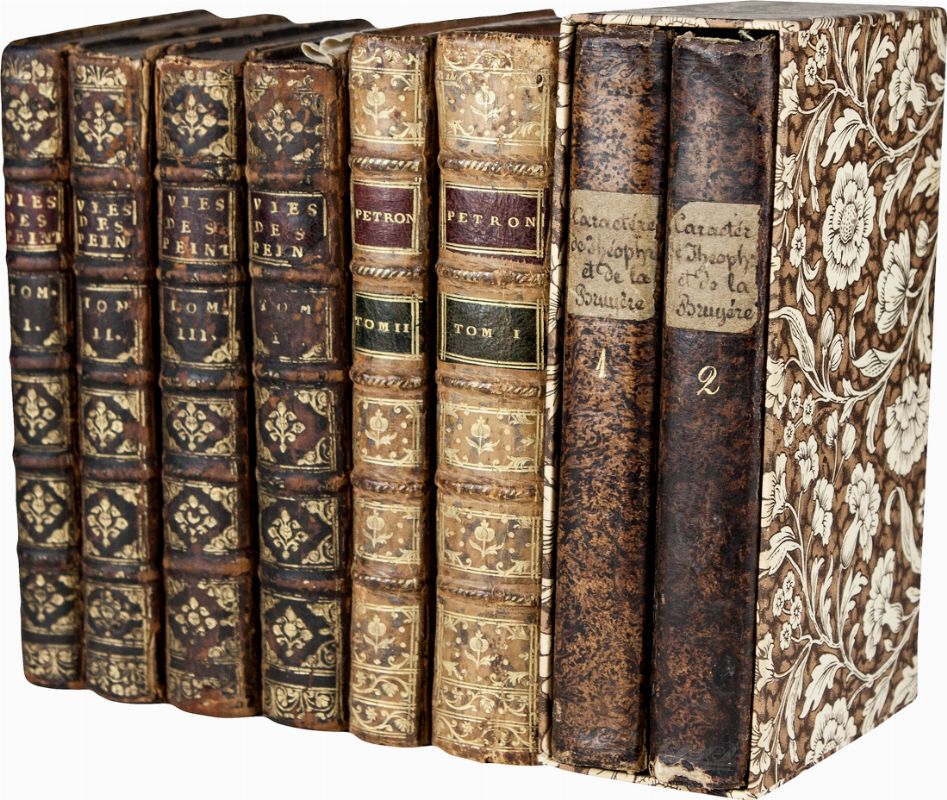THEOPHRASTUS (c. 371-c. 287 B.C.). De historia et causis plantarum . Translated from Greek intro Latin by Theodorus Gaza (fl. 1400-75), edited by Georgius Merula (d. 1494). Treviso: Bartholomaeus Confalonerius, 20 February 1483.
THEOPHRASTUS (c. 371-c. 287 B.C.). De historia et causis plantarum . Translated from Greek intro Latin by Theodorus Gaza (fl. 1400-75), edited by Georgius Merula (d. 1494). Treviso: Bartholomaeus Confalonerius, 20 February 1483. Super-chancery 2º (303 x 206mm). Collation: A-H8 I-L6; a8 b6 c-h8 i-k6 (A1 blank, A2r-A2v translator's dedication to Pope Nicholas V, A2v-A4v translator's preface, A4v-K6r Historia plantarum , K6v letter of Georgius Merula to Dominicus Sanuto, L1r-L6v table; a1r-k6r De causis plantarum, k6r colophon, k6v blank). 156 leaves. 41 lines, table in two columns. 9- to 2-line initial spaces, most with printed guide-letter. Printed shoulder notes to De causis plantarum . (Occasional light spotting, faint marginal dampstain in a few leaves, marginal spot and small wormhole in final 3 leaves.) Contemporary ?French calf over wooden boards, panelled and with foliate roll tools, author’s name lettered along bottom edges and in a contemporary hand on first blank (rebacked, new endpapers, a little stained and worn, lacking fore-edge clasps). Provenance: early marginal annotations in Greek and Latin, those in the first two quires including references to the Aldine edition which formed part of the Aldine Aristotle of 1495-8 -- Muzio Capilupi (secretary of Vespasiano Gonzaga (1531-1591) and vicar of Sabbioneta (near Mantua); contemporary inscription on first leaf). RARE FIRST EDITION of the first work of scientific botany. Theophrastus was Aristotle's associate, his successor as head of the Peripatetic School, and heir to his library. His treatises on plants, written as counterparts to Aristotle's works on animals, came to be regarded as part of the Aristotelian corpus; their original Greek texts were first printed in the Aldine edition of Aristotle's works (Norman 70). The Historia plantarum is concerned with the description, classification, and analysis of plants; De causis plantarum with their generation and propagation. The former describes more than 500 varieties of plants according to a primitive classification scheme that held into the sixteenth century, and offers a description of germinating seeds that was the clearest and most accurate before Malpighi's study in the seventeenth century (Norman 1430). The discussion of the medicinal properties of plants in Book IX of the Historia makes the work one of the earliest surviving herbals. The present copy was owned by a contemporary scholar who annotated the first chapters in Greek and Latin, noting variant readings and with reference to the first edition in Greek, printed by Aldus Manutius These variant readings continued to be noted in later editions; it may be significant that there are no references to the 1541 edition, dating the annotations to before 1541. HC 15491*; BMC VI, 894 (IB. 28409); Klebs 958.1; Proctor 6480; Dibner Heralds of Science 18; GM 1783; Stillwell Science 533, 702; Norman 2066; Goff T-155.
THEOPHRASTUS (c. 371-c. 287 B.C.). De historia et causis plantarum . Translated from Greek intro Latin by Theodorus Gaza (fl. 1400-75), edited by Georgius Merula (d. 1494). Treviso: Bartholomaeus Confalonerius, 20 February 1483.
THEOPHRASTUS (c. 371-c. 287 B.C.). De historia et causis plantarum . Translated from Greek intro Latin by Theodorus Gaza (fl. 1400-75), edited by Georgius Merula (d. 1494). Treviso: Bartholomaeus Confalonerius, 20 February 1483. Super-chancery 2º (303 x 206mm). Collation: A-H8 I-L6; a8 b6 c-h8 i-k6 (A1 blank, A2r-A2v translator's dedication to Pope Nicholas V, A2v-A4v translator's preface, A4v-K6r Historia plantarum , K6v letter of Georgius Merula to Dominicus Sanuto, L1r-L6v table; a1r-k6r De causis plantarum, k6r colophon, k6v blank). 156 leaves. 41 lines, table in two columns. 9- to 2-line initial spaces, most with printed guide-letter. Printed shoulder notes to De causis plantarum . (Occasional light spotting, faint marginal dampstain in a few leaves, marginal spot and small wormhole in final 3 leaves.) Contemporary ?French calf over wooden boards, panelled and with foliate roll tools, author’s name lettered along bottom edges and in a contemporary hand on first blank (rebacked, new endpapers, a little stained and worn, lacking fore-edge clasps). Provenance: early marginal annotations in Greek and Latin, those in the first two quires including references to the Aldine edition which formed part of the Aldine Aristotle of 1495-8 -- Muzio Capilupi (secretary of Vespasiano Gonzaga (1531-1591) and vicar of Sabbioneta (near Mantua); contemporary inscription on first leaf). RARE FIRST EDITION of the first work of scientific botany. Theophrastus was Aristotle's associate, his successor as head of the Peripatetic School, and heir to his library. His treatises on plants, written as counterparts to Aristotle's works on animals, came to be regarded as part of the Aristotelian corpus; their original Greek texts were first printed in the Aldine edition of Aristotle's works (Norman 70). The Historia plantarum is concerned with the description, classification, and analysis of plants; De causis plantarum with their generation and propagation. The former describes more than 500 varieties of plants according to a primitive classification scheme that held into the sixteenth century, and offers a description of germinating seeds that was the clearest and most accurate before Malpighi's study in the seventeenth century (Norman 1430). The discussion of the medicinal properties of plants in Book IX of the Historia makes the work one of the earliest surviving herbals. The present copy was owned by a contemporary scholar who annotated the first chapters in Greek and Latin, noting variant readings and with reference to the first edition in Greek, printed by Aldus Manutius These variant readings continued to be noted in later editions; it may be significant that there are no references to the 1541 edition, dating the annotations to before 1541. HC 15491*; BMC VI, 894 (IB. 28409); Klebs 958.1; Proctor 6480; Dibner Heralds of Science 18; GM 1783; Stillwell Science 533, 702; Norman 2066; Goff T-155.



.jpg)






Testen Sie LotSearch und seine Premium-Features 7 Tage - ohne Kosten!
Lassen Sie sich automatisch über neue Objekte in kommenden Auktionen benachrichtigen.
Suchauftrag anlegen